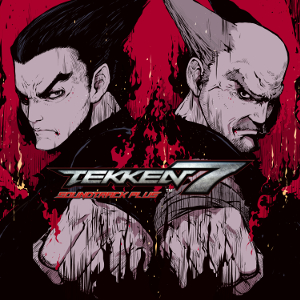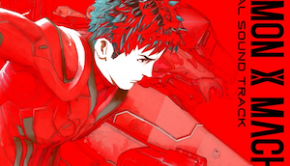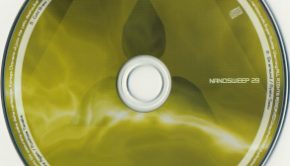Tekken 7 Soundtrack PLUS
 |
Album Title: Tekken 7 Soundtrack PLUS |
| Record Label: Sweep Record |
|
| Catalog No.: SRIN-1137 |
|
| Release Date: October 31, 2017 |
|
| Purchase: Buy at CDJapan |
Overview
The Tekken 7 Soundtrack PLUS contains the music added to the game after its initial arcade release. Much of the soundtrack for the new console stages and story mode, however, there are also tracks from the Fated Retribution arcade update released in late 2016. Building on the foundation of the original soundtrack, Rio Hamamoto is joined by Taku Inoue, Go Shiina, Yuu Miyake, Hiroshi Okubo, and AJURIKA, to provide much of the new music featured in the game. In addition, there are a multitude of ending themes and softer themes, including Spanish folk tunes, to help round out the soundtrack. Does the additional music featured on this release match well with the previous sound established during the initial release?
Body
Guest and singular contributions, both from current and former Namco composers, have been a part of Tekken history in recent years and the console release of Tekken 7 continues this. Both Hiroshi Okubo and Go Shiina, the latter of whom is now freelance, both contribute two tracks that play on the stage for which they are responsible. Okubo’s “VioletSystems 1st” is an outstanding drum n’ bass tune with strong industrial and dark undertones with its heavy beats, cinematic hits, and exhilarating tempo as the track builds. It has been a while since Okubo has put out something this heavy, but the end result is a tune that fits absolutely within the confines of both the original Tekken 7 soundtrack and a majority of the new stage themes. “VioletSystems 2nd” continues with the drum n’ bass vibe, but adds more modulation/wobble, giving it a bit of a drumstep influence while still retaining the heavy hitting beats and industrial flavor of the non-final round version.
On the other side of the spectrum is Go Shiina’s “DUOMO DI SIRIO 1st,” an orchestral/rock tune that incorporates choir, brass, strings, drums, and electric guitar. There is a nice progression to the piece, with moments of calm and energy, as well as an electric guitar solo to break things up. The end result features excellent production values; the issue I have with the tune is that it sounds more like an unusued God Eater tune as the major melody prominently featured throughout the piece certainly bears extremely similar, if not exact, hallmarks to that series. “DUOMO DI SIRIO 2nd” is more choral forward and drops the rock aspect of the piece, but given the backbone is the same melody as the non-final round version, it, too, sounds like it belongs more in a God Eater game rather than something more original and unique, like his earlier Tekken contributions.
AJURIKA offers three contributions the the soundtrack. The first, “I’m Here Now 7’s Remix,” is a modern take on the opening theme to Tekken 5, and to my understanding, is played during the story mode that recreates the opening scene of the aforementioned game. There is more of a drum n’ bass influence with glitchy electronic tones, both complementing the synth melody that plays above it. The other adapts his opening theme from Tekken 7, “Heat Haze Shadow,” into a stage theme. “Heat Haze Shadow 1st” has a glitchy drum n’ bass/psytrance sound and eliminates the vocals present in the opening theme. In addition, there are some excellent electronic flourishes and manipulation presented as well. “Heat Haze Shadow 2nd” is more akin to the original stylistically. The drum n’ bass influence is kept, vocals are reincorporated, and glitchy synths and distortions accompany the tune to give it a more final round essence.
Yuu Miyake is another strong force on the album overall, despite his minimal contributions. “Attack on Rhythm 1st,” first and foremost, features an outstanding melody with an beautiful build up; however, the second half features more typical dubstep sounds that don’t particularly stand out, but are at least buoyed somewhat by the excellent synth sounds and textures in the accompaniment. “Attack on Rhythm 2nd” retains a similar atmosphere to the original, albeit with a bit more exoticism in the overall tone. However, rather than repeat with another typical dubstep drop, the second half is more glitchy, features less distortion, and is more melodically fragmented. Miyake’s “Metallic Experience 1st” is by far his strongest contribution to the soundtrack. It is an absolutely exquisite piece blending deep drum n’ bass beasts with a warm, yet melancholy, strings melody that dominates the piece. The B section of the piece is certainly keeps with his dubstep ideas, but is more gritty, industrial, and melodically focused and juxtaposes nicely with the choir. If one didn’t know any better, someone might confuse this piece with one of Keiichi Okabe’s earlier Tekken tunes, given the style. “Metallic Experience 2nd” ups the drum n’ bass sound, moves to a quicker tempo, but retains the industrial and cold drumstep elements of the former, while letting the choir shine a bit more. It’s an intense tune, fitting for a final round. In addition, “The Motion,” has a bit of a house vibe and plays both while searching for an online opponent and as the practice stage music. It’s an extremely long tune, compared to many of the stage themes on the album, but doesn’t feel stale given the various accompaniments to the piece. The softer piano helps give it more of a trance feel when it is playing while the more synth oriented sections give it a nice catchy rhythm that you can bob your head to as you listen.
The majority of the new menu and stage music was composed by Taku Inoue and Rio Hamamoto. Inoue’s “Solitude” is an absolutely exquisite piece, blending delicate piano with jazzy drum rhythms, heavy beats, and synths. It serves as a nice title screen and the piano and drum rhythms serve as the primary backbone to the vocal tune, “Aloneness,” where these two elements are combined with soft vocals, strings, intricate rhythms, and electronic beats. In addition, there is also a version that blends the vocal tune from Tekken 7‘s arcade version, “The Long Goodbye,” that seems a minor touch-up, while retaining a large majority of the original’s sound. The character selection music, “Tonight is the Night,” has a similar vibe to “Fight Night” from the Tekken 7 arcade version, and features rock drums, distorted synths, and a catchy, albeit, somewhat repetitive melody. The customization theme, “Midnight Closet,” on the other hand, definitely has some R&B rhythms and an absolutely beautiful synth melody. It has both a 80s and modern vibe to it and complements the groovy beats.
Inoue’s stage themes all offer an overall different sound to them, allowing Inoue to experiment, in some cases, away from his Tekken style established in previous titles. “Distorter 1st,” which plays on the helipad stage’s night version combines grungy guitar with drum n’ bass and high pitched synths that definitely give off more of a metal sound, something I’d have expected more from Rio Hamamoto rather than Inoue. It may not have the strongest melody, but the atmosphere is absolutely top notch. Likewise, “Distorter 2nd” ups the ante a bit with its grungy elements but incorporating more hardcore techno beats. The high pitched synths are also present and dominate a majority of the piece; however, the second half the piece combines the gritty rock with trap beats, both going extremely well together. However, those who don’t like the higher pitched sounds will probably find less enjoyment from this piece. The day version of the helipad stage is accompanied by “Lonesome City Jazz Party 1st,” opening with soft jazzy tones before moving into an EDM banger with a ton of energy. I think it really fits the stage quite well and adds a nice energy to the fights. However, I much prefer “Lonesome City Jazz Party 2nd,” which forgoes more of the jazz elements, and focuses more on the high energy EDM of the first iteration. However, I really love how Inoue takes the same trap beats present in “Distorter 2nd,” and combines it with the faster tones present in the first half of the tune. It makes for an interesting juxtaposition of fast and slow. It’s another tune that may not be the most melodically forward, but excels at creating a fitting atmosphere. However, when it comes to the Inoue stage themes, “Moonsiders 1st” is the clear winner. It combines soft piano and a soft drum n’ bass beat to craft a beautiful atmosphere with an equally beautiful melody. This melody, while present in “Moonsiders 2nd,” is definitely put aside and only featured towards the end of the track, while the front part of the tune is loaded with intricate drum n’ bass rhythms and fragmented melodic ideas. While I certainly enjoy this tune quite a bit, the internet certainly is divided.
Being the lead composer for the title, Rio Hamamoto plays a large role on the soundtrack. His responsibilities are more towards the story related stage themes, but he also does his fair share of regular stage themes as well. For his story related music, they are generally orchestral focused with electronic elements giving them a very cinematic feel. “Beginning of the end” is one such tune with a brass/strings dominant melody over distorted electronic tones giving it a very industrial flavor. Likewise, “Beginning” is an exhilarating track featuring a faster tempo, distorted and glitchy synths with strong percussion and brass hits. “House of Hachijyou” is another brass forward cinematic track but also incorporates taiko drums and choir, in addition to the gritty distorted electronic components that dominate the story mode tracks. “Hatred” is another tune that takes this approach, but is more choral driven in addition to the brass. Both “Desperate Struggle” and “Destiny” both incorporate snippets of “Kazumi’s Theme” given both a more cinematic feel to them. While they aren’t necessarily standout tracks, they are well produced and fit within the context of the game.
His stage themes are a bit more varied, but some carry a similar trend as above. “BRIMSTONE & FIRE 1st” features distorted synths, industrial tones, and a cinematic sound with the orchestral components. The melody itself is quite beautiful and juxtapositions nicely with the more raw elements of the piece. In some ways, it reminds me of the “Volcano” set of tracks. The second iteration adds more heavy metal elements to it in the form of guitar riffs and a more prominent choral sound to it that helps give it a bit more grit. “PRECIPICE OF FATE 1st” is more discordant with its distorted synth focus, gritty and dirty synth elements, and an overall industrial sound. The melody is a bit lost, but there is a lot of raw energy in this tune. The second iteration adds choir, a faster tempo, and a clearer focus on melody, while also incorporating strings throughout the piece. It is certainly the more accessible of the two tunes. “Hideaway 1st” is more grungy rock in approach while also incorporating electro beats giving it a nice flow and a heavy tone overall. Its second iteration is arguably “softer.” Vocal elements are added, the focus is more beat focused, although the grunge is still present to some degree. In addition, the melody is excellent and works well with the aforementioned elements.
“KINDER GYM 1st” is most likely the “joke” stage of this game. It’s quite a playful tune with its synth melody and dance beats. The second version of it ups the tempo and adds a bit more distortion compared to the first tune. Not Hamamoto’s strongest tune, but still enjoyable. More Japanese/rock fusion focused is “A・U・N 1st.” Heavy focus on taiko drums creates most of the rhythm heard throughout the piece while sharp woodwinds (shakuhachi), distorted synths, and gritty rock combine to form an excellent atmosphere and an edgy melody. The second iteration adds more heavy rock riffs and electronic distortion while focusing more on shamisen (or koto) sounds to help drive the melody. The drum/plucked string combination is an excellent one and really helps elevate the piece. Hamamoto’s “Abandoned Temple Final 1st” is certainly more cinematic in approach with a strong focus on choral elements, cinematic electronic undertones, while still incorporating some of the rock/Japanese elements heard in “A・U・N.” The second iteration is more metal focused version with electronic elements in the accompaniment. What I really enjoy about this is how the shakuhachi’s sharp woodwind sounds help break up some of the heaviness, but also complementing it as well. There is a great incorporation of the Japanese instrumentation in this piece and it certainly stands as one of Hamamoto’s strongest on the soundtrack.
The third disc consists of additional story mode tracks and the various endings of the game. The endings, composed by a variety of individuals, all carry different sounds, but are rather short overall and are more filler-like. However, Katsuro Tajima’s contributions show a softer side of the album, showcasing flamenco guitar and giving many of his tunes a very Spanish sound, which I take is deliberate to go along with the various Spanish folk songs and other songs of Spanish origin. The third disc is certainly a nice break from the overall heavy sound of the actual fighting related tracks, but I’d say the real meat of the release are the remaining discs.
Summary
Overall, the Tekken 7 Plus Soundtrack adds quite a few new tracks to the original Tekken 7 arcade release. The guest contributions are generally well produced and fit within the overall tone of the soundtrack while Hamamoto and Inoue’s tracks offer vastly different experiences, but help define the overall Tekken 7 sound and complement the arcade release’s stage themes quite well. Fans of the Tekken 7 Soundtrack will certainly find lots to enjoy with this album, but those who aren’t fans of the current direction of modern Tekken soundtracks will find less to like about the release.
Do you agree with the review and score? Let us know in the comments below!
4
Posted on January 3, 2018 by Don Kotowski. Last modified on January 3, 2018.














